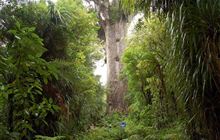Stronger action to protect iconic kauri
Archived content: This media release was accurate on the date of publication.
Introduction
The Government will move immediately to strengthen efforts to protect kauri trees from dieback disease.Date: 20 December 2017 Source: Offices of the Minister of Conservation and Minister of Biosecurity
The Government will move immediately to strengthen efforts to protect kauri trees from dieback disease, Biosecurity Minister Damien O’Connor and Conservation Minister Eugenie Sage have announced.
“We have asked the Kauri Dieback Programme to develop a National Pest Management Plan (NPMP) in light of the continued spread of this disease, which has the potential to take kauri to the brink of extinction,” Mr O’Connor says.
“An NPMP shows how serious we are about protecting kauri. It is by far the strongest piece of regulation available and will ensure mandatory hygiene practices, consistent regulations that apply nationally, stronger governance and access to funding.”
National Pest Management Plans have previously been used to combat major threats to the primary sector such as the kiwifruit disease Psa, bovine tuberculosis and American foulbrood, a bee disease.
Although there are large areas still free of the disease, Mr O’Connor says it is sensible to have more options available to reduce the risk of kauri dieback spreading to uninfected trees.
Other measures which can come into force quickly through the Biosecurity Act are also under consideration, including an interim Controlled Area Notice (CAN) applying to kauri forests. This could be used to introduce mandatory minimum hygiene standards for people to follow when going into areas that have kauri and to close areas to visitors.
“To date, we have relied on people voluntarily complying with the rules when visiting kauri areas – that they must clean their footwear, stay on marked tracks, and keep their dogs on leashes. That approach has not worked, so it is time that we come up with tougher solutions,” Mr O’Connor says.
Conservation Minister Eugenie Sage says kauri are a New Zealand icon and urgent and effective action is needed. An NPMP will give Government better tools to respond to the crisis.
“DOC has undertaken a $21.6 million track upgrade programme to reduce the risk of dieback being spread by visitors to conservation land carrying mud on their footwear with some success. However, kauri dieback is like a biological bulldozer and the programme needs broader powers and stronger leadership in order to prevent it driving these forest giants into extinction. We are not prepared to stand by and let it happen.”
“All New Zealanders and visitors to our country have a role to play in protecting kauri and taking personal responsibility to follow good hygiene practices and reduce the risk of spreading the disease.”
The Kauri Dieback Programme was launched in 2009 to manage and respond to the spread of kauri dieback, and is a partnership between regional councils, MPI, DOC and iwi.
Contact
For media enquiries contact:
Email: media@doc.govt.nz


